Redefining Spanish Wines: Catalunya’s Deeply Rooted, Daringly Innovative Wine Culture In The New Age Four Neo-vignerons (9-Bottle Red, White & Rosé Pack For $285)
All Things Catalunyan: Join Us for Saturday Sips To Usher In “La Diada de Sant Jordi’
‘La Diada de Sant Jordi’ falls on April 23 in the Catalan holiday calendar, a day of books and roses, and it is a great reason to resume our all-day, in-store Saturday Sips. Among the themes we will be exploring in weeks to come is ‘vinecology’—the agricultural and techno-fixes that will alter the world of wine as profoundly as global climate change is altering traditional (and non-traditional) wine growing areas.
(Climate) Change Is Afoot In Catalunya
With apologies to Professor Higgins, the rain in Spain is not only dodging the plains, it’s playing havoc up and down the entire Mediterranean coast, extending from Spain to North Africa and Sicily as well. Last year, this persistent drought ranked among the ten most costly climate disasters in the world, and in real time, Catalunya is undergoing the worst drought in a century, with water reserves at 16% of capacity. Hotels are filling swimming pools with seawater and those whose livelihoods are tied to agriculture are wondering what the intensity of this summer will bring; last year, fruit growers threw out entire crops in order to use their diminishing water supplies to save their trees. Even traditionally dry-farmed industries like olive production and wine growing are crippled by these severe heat waves, and farmers who irrigate have it even worse, since by law, they are the first ones to relinquish water rights.
Adaptation to the climate crisis is happening throughout Catalunya; there is no other choice. But to date, much of it improvised and tends to take place only when the worst has already happened. Like the old Inuit following the caribou, modern winemakers are being forced to follow the thermometer, and this has led to an exploration of vineyard space in regions that were once too cold to produce reliable harvests.
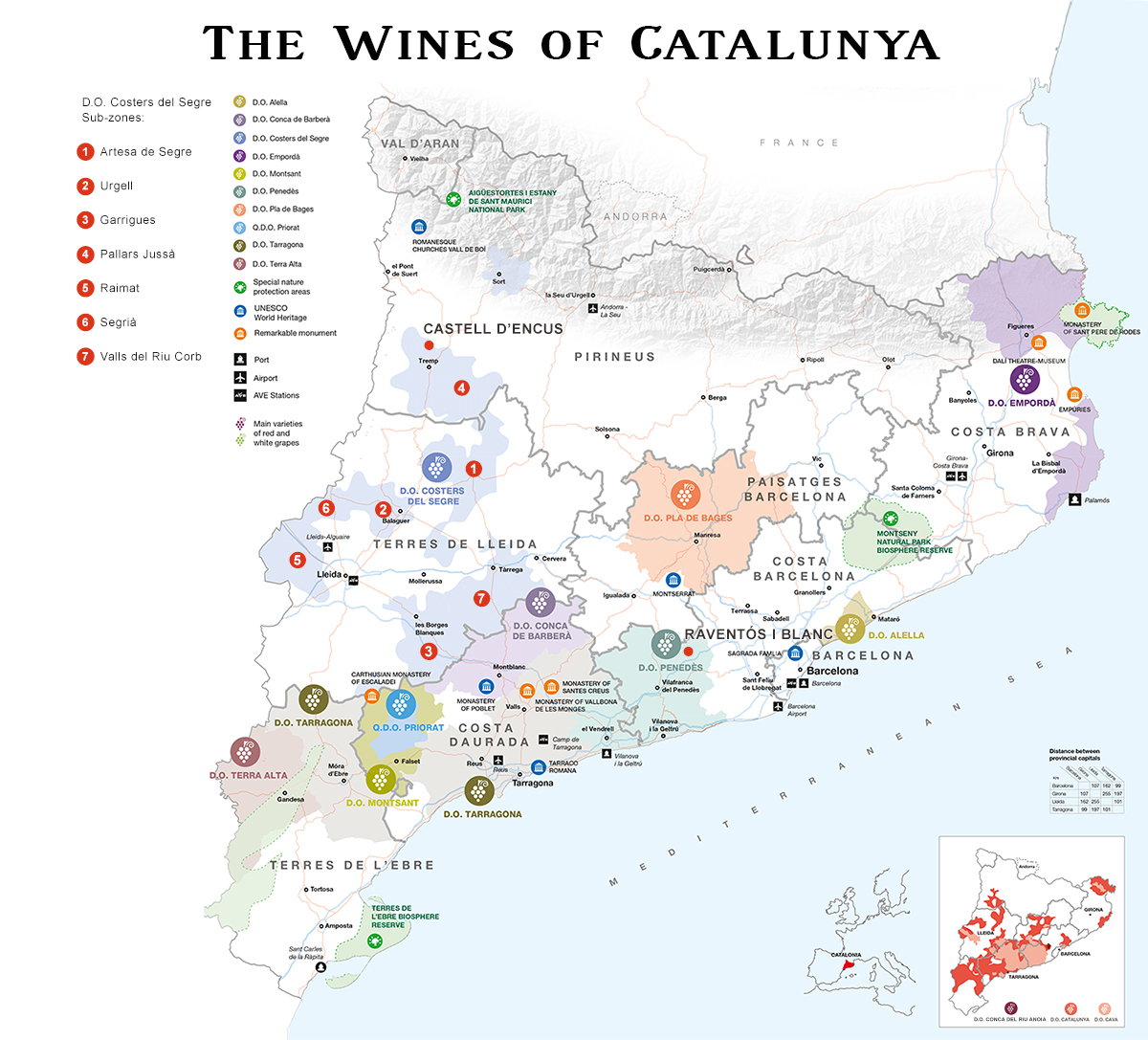
The Vigneron’s Dilemma
It’s no secret that grape vines have been known to produce the best wines where the challenges are greatest. Vines placed under natural stress, struggling to find water and nutrients, tend to produce fruit that is more vibrant in flavor and balanced in acid with smoother tannins. Sites that are flat, well-irrigated and sunny have long been considered ‘no-brainer terroirs’ that over-produce and under-perform.
When challenged by drought, producers of this industrial-style wine reach into pockets deeper than the aquifers, and they will survive. The small winegrower, faced with mounting losses and plummeting harvests, are like the vines themselves: Sooner or later, they simply wither away.
And it is not just dryness. In Penedès, 2020 brought two times the rain of a normal year, which was followed by three years of drought. The unpredictable nature of climate change takes an emotional toll on the winemakers as well as a financial one. The dilemma they face is often less about a desire to change and more about the clock: It is well-established that vineyards stationed at higher altitudes are able to retain more water and produce higher-quality grapes, and that some varieties are more drought-resistant than others. But starting over in new regions takes time, and as climatic conditions worse, sadly, time is a resource that many wineries simply do not have.
Counter Or Adapt
With equal apologies to Jim Morrison and The Doors: Girl, when your vineyards becomes as hot as a funeral pyre, take it higher. The most delicious irony in changing weather patterns may be that regions once considered too cold for vines are warming to the point that they can produce quality wines. In Catalunya, vineyards at the foothills of the Pyrenees are being planted at altitudes up to 4,000 feet. “Twenty-five years ago, it would have been impossible,” says Miguel Torres Maczassek of Familia Torres. “At higher elevations, peak temperatures are not necessarily much cooler, but intense heat lasts for shorter periods and nighttime temperatures are colder than at lower altitudes. This increased diurnal shift (the temperature swing over the course of a day) helps grapes to ripen at a more even pace, over a longer period of time, than where temperatures remain relatively stable.”
But pushing altitudes also creates challenges: Soils, particularly on slopes, are generally poorer, water is scarcer and unexpected weather events like frosts and hailstorms are always a threat. Whereas this may ultimately result in better wine overall, the challenges for winemakers are prodigious. In the northeast of Spain, including coastal vineyards, the response has been two-fold: Adapt current vineyards to the ‘new normal’ by replanting to more heat-tolerant varietals, or eke out space at higher elevations to take advantage of the plus-side of a global negative.
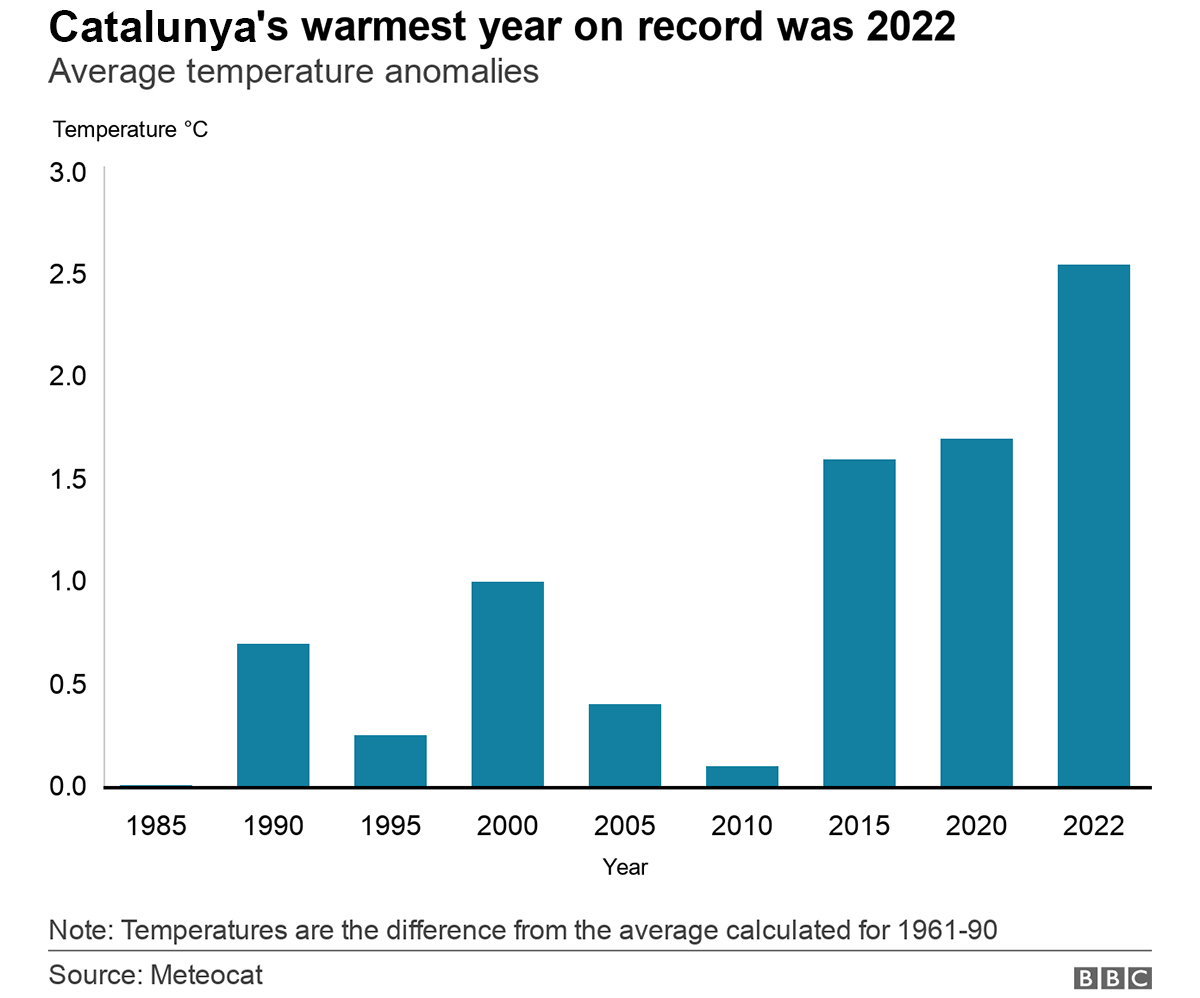
Penedès
Uphill, Wealth Of Indigenous Grape Riches
About an hour south of Barcelona, nestled splendidly between the mountains and the sea, Penedès is most active growing region in Catalunya. The region contains some of the oldest wine-growing appellations in Europe, and produces consistently and reliably thanks to a multitude of terroirs. The region is best known for Cava, Spain’s answer to Méthode Champenoise sparkling wine, generally produced from the trinity of indigenous grapes, Macabeu, Parellada and Xarel·lo, occasionally fattened-up with Chardonnay, Pinot Noir, Garnatxa and Monastrell. All are permitted in various concentrations for Cava blends.
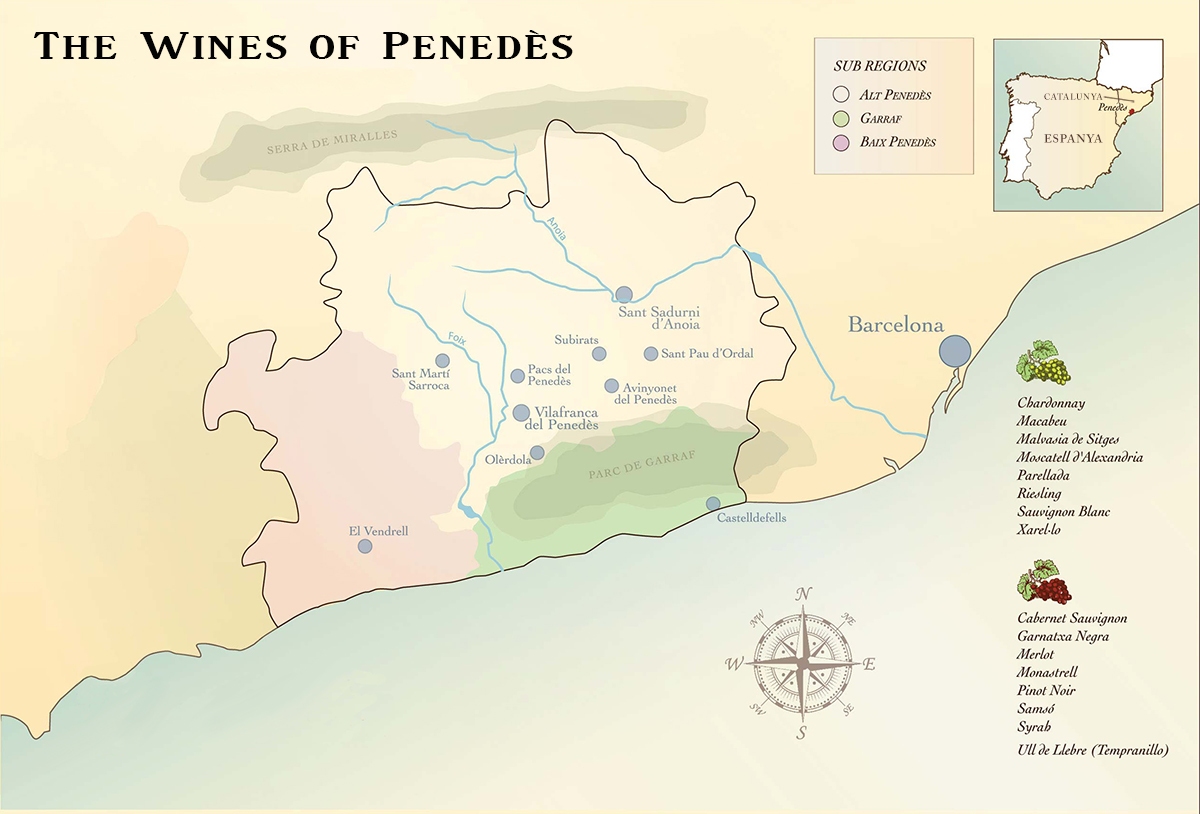
Roughly divided into three subzones, the mountainous Alt-Penedès produces the highest quality wine, followed by Baix Penedès in the low-lying coastal areas and Penedès Central, responsible for most of the region’s bulk production.
Although the area has been making wine since the days of the Phoenicians, Penedès’ modern era began in 1960 when its DO designation was granted, and—largely through the efforts of Miguel Torres—the region as a whole began to upgrade production methods, including temperature-controlled fermentation in stainless steel tanks and experimentation with non-indigenous grape varieties such as Merlot and Cabernet Sauvignon. Since then, although quality has skyrocketed among all the wines of Penedès, the region remains known primarily for its sparkling wines, making the highly regarded, oak-aged reds and crisp, vibrant whites (especially those made with the Cava standby Xarel·lo) part of a remarkable journey of discovery.
VallDolina
The name ‘VallDolina’ is a description of the landscape surrounding Can Tutusaus, an estate which has stood amid these pine groves since 1348. ‘Dolinas’ are depressions formed in areas rich in limestone soils while ‘vall’ is Catalan for valley. In 1987, seduced by this mysterious land, Joan Badell bottled his first wines and planted his first trained vines. In 1999, his son Raimon, who was then studying oenology, became a close collaborator and opted to turn the estate toward ecological and biodynamic agriculture.
“Bottling the land,” is the way that Raimon Badell describes his interpretation of winemaking. “We only work with grapes picked from this estate,” he says, “where vines are situated between 800 and 1500 feet above sea level, bordering the Natural Park of the Massís del Garraf. The vineyards grow on hills with calcareous-clay soil and produce where the climate is distinctly Mediterranean, strongly influenced by the vicinity of the sea.”
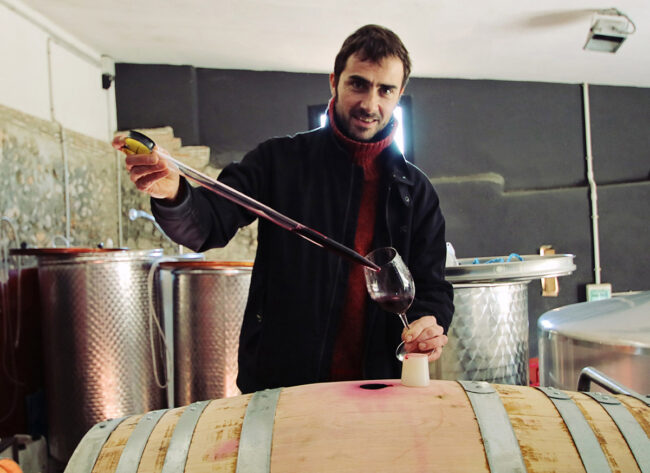
Raimon Badell
As a team, Raimon and his wife Anna have replanted the ancient terraces set in a property otherwise dominated by pine trees interspersed with glimpses of the Mediterranean Sea. The oldest vines at Tutusaus were planted during a last-century’s craze for international grape varieties, and the Merlot remains an outstanding Spanish example of this variety.
Anna adds, “VallDolina identifies with the territory with the aim that our wines offer a sensitive expression of the landscape, with the idea of determining the different tasks following the lunar calendar as our grandparents did and at the same time using agricultural concepts the most environmentally friendly.”
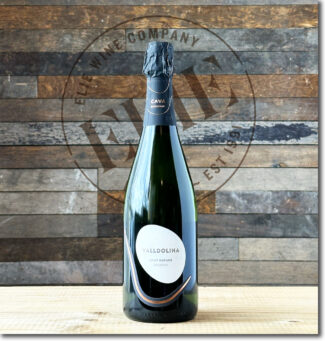 1 VallDolina, 2020 Cava Reserva Brut-Nature ($19) Sparkling
1 VallDolina, 2020 Cava Reserva Brut-Nature ($19) Sparkling
The three traditional Cava varieties, 38% Xarel·lo, 32% Macabeu, 22% Parellada with 8% splash of Chardonnay sourced from estate-owned, organically certified vineyards with red clay and limestone soils. Vinified and fermented in stainless steel tanks, with secondary fermentation inside the bottle and 24 months on lees before disgorgement.
Alemany i Corrio
There are matches made in Heaven and those made in vineyards; credit the latter to the life partnership of Irene Alemany and Laurent Corrio, whose small-batch, low-intervention wines are proving that the Alt-Penedès is among the most exciting places to be making wine today. Great wine is a technical beast, but without the intensity of passion, it loses much of its savor: “Our wine is as soft as a gentle kiss, but one where you end by biting your partner’s lip,” says Irene.
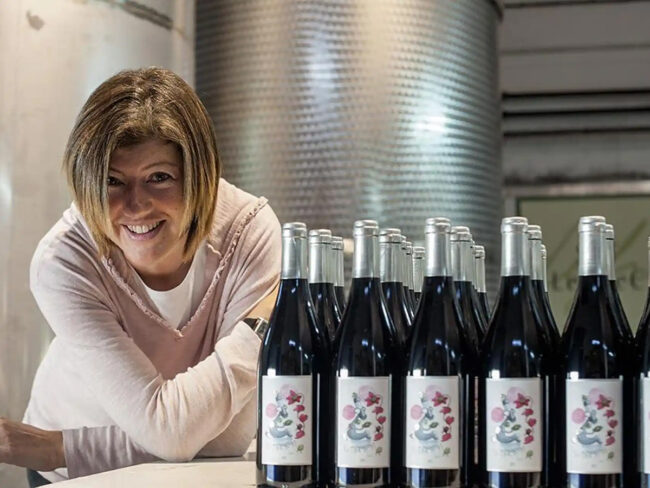
Irene Alemany
The couple met at the University of Burgundy in Dijon, then apprenticed together in vineyards in France and California. But their future was written in chalk and loam following a visit to Irene’s parents in Lavern in the Penedès; that was when Irene’s father suggested that they consider using the family vines to start their own operation. This treasure trove encompassed several varieties of grapes between 25 and 60 years old. They leapt at the opportunity—their first harvest was in 1999 and their first bottling in 2002. From the beginning, they followed their French training, remaking the classics in their own way, keeping the process as natural as possible while seeking to reflect the expression of the varieties and the character of the terroir to the maximum extent.
In the process, they are credited with producing the first ‘garage’ wines of New Penedès. Their ‘Vi de Garatge’ series may be thought of as ‘tailor-made’ wines relying on precision in both field and cellar.
“What we want to accomplish,” says Irene, “is that when people taste our wines there is something in the soul of the wine that talks to them and will make them remember.”
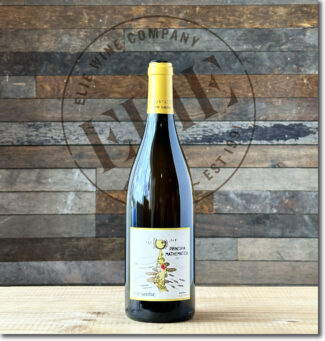 2 Alemany i Corrió ‘Principia Mathematica’, 2022 Vi de Garatge ‘Penedès’ ($30) White
2 Alemany i Corrió ‘Principia Mathematica’, 2022 Vi de Garatge ‘Penedès’ ($30) White
100% Xarel·lo – Originating with low-yields from a seven-acre plot where the vines are over fifty years old, Principia Mathematica was fermented in French oak (10% new) and aged for ten months in foudres/stainless steel. The wine shows a Meursault-esque intensity beneath crisp white stone fruit, notably apricot, defined by a light toasted-almond undertow. 665 cases produced.
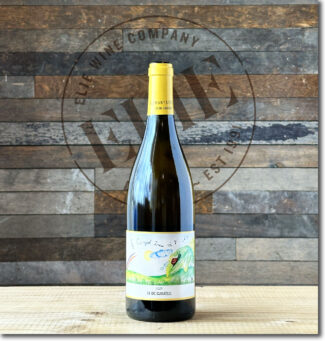 3 Alemany i Corrió ‘Cargol Treu Vi’, 2021 Vi de Garatge ‘Penedès’ ($31) White
3 Alemany i Corrió ‘Cargol Treu Vi’, 2021 Vi de Garatge ‘Penedès’ ($31) White
Another pure Xarel·lo beauty; Cargol Treu Vi comes from 75 year old vines planted on chalky soil, then vinified on wild yeast in 300 liter French oak barrels, 25% new. The wine shows spring flowers, stone fruit and lemon zest behind hints of smoke with a long, salt-tinged finish. 175 cases produced.
Can Sumoi
Into a rarified atmosphere of Catalunyan pride and passion and secessionist spirit, Pepe Raventós has embellished the canvas with his own unique set of colors. Born to the vine and enamored of the bosky hills and sprawling vineyards of Catalan wine country, Raventós spent his childhood picking grapes at Sant Sadurní d’Anoia. Sant Sadurní is, of course, the home of more than eighty Cava producers and wine is cornerstone of the local economy. It’s also where 21 generations of Pepe Raventós’ family have lived, dating back to the 15th century.
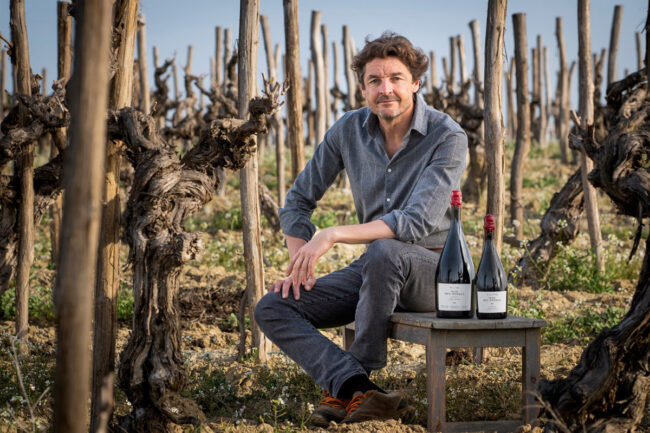
Pepe Raventós
At two thousand feet above sea level (in the Serra de l’Home range) Can Sumoi is the highest estate in the Penedès; Mallorca and the Ebro Delta are visible from the rooftop of the winery’s 350-year-old farmhouse. Below, 50 acres of vineyards sprawl across limestone-rich soil between stands of oak and white pine, which to the ecology-driven Raventós, share equal importance with the vines. “Forests,” he says, “protect the biodiversity of the estate; they are the green lungs of the world.”
The wines of Can Sumoi are also green insofar as they are produced using Certified Organic methods; vineyards are tended with natural compost, free of pesticides and with minimal intervention; a herd of sheep and goats is allowed to graze semi-freely among the vines. Certain esoteric biodynamic techniques may sound strange to laymen (such as timing vineyard activity to the phases of the moon) but to Raventós, they make perfect sense: “When the moon is ascendant, plant fluids concentrate more towards the roots of plants, and that’s when you want to do the pruning—so you don’t damage the plant.”
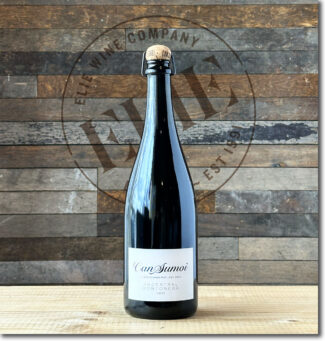 4 Can Sumoi ‘Montònega’, 2021 Espumoso ‘Ancestral’ Brut-Nature ($27) Sparkling
4 Can Sumoi ‘Montònega’, 2021 Espumoso ‘Ancestral’ Brut-Nature ($27) Sparkling
Montònega is a pink-berried clone of Parellada capable of producing excellent monovarietal sparkling wines, particularly when cultivated in the high-altitude Pla de Manlleu of Penedès. The wine is Pet-Nat, meaning that it is made via the traditional method without additives, stabilization or filtration. The wine is dry and savory with delicate aromas of apple skin and citrus.
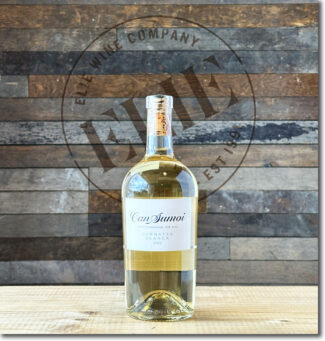 5 Can Sumoi ‘Garnatxa Blanca’, 2022 ‘Penedès’ ($28) White
5 Can Sumoi ‘Garnatxa Blanca’, 2022 ‘Penedès’ ($28) White
This golden-hued mutation of the dark-skinned Garnatxa Negra originated in northern Spain. Can Sumoi’s is drawn from vineyards in the Serra del Montmell, nearly two thousand feet above sea level where the soils are stony and limestone-based. The wine shows apricot and lychee as well as green fruits like honeydew and pear, but the herbal quality is a defining feature.
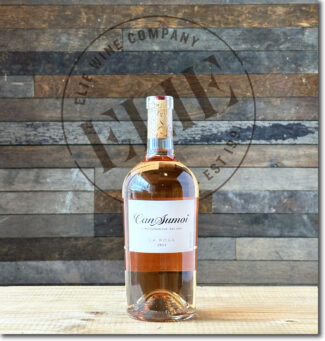 6 Can Sumoi ‘La Rosa’, 2022 Penedès ($26) Rosé
6 Can Sumoi ‘La Rosa’, 2022 Penedès ($26) Rosé
An aromatic rosé made from high-altitude Xarel·lo and Sumoll, destemmed, lightly crushed and briefly macerated, with fermentation carried out in stainless steel tanks on indigenous yeasts. A distinct and elegant expression of Mediterranean character with wild strawberry and citrus notes behind a springtime floral bouquet.
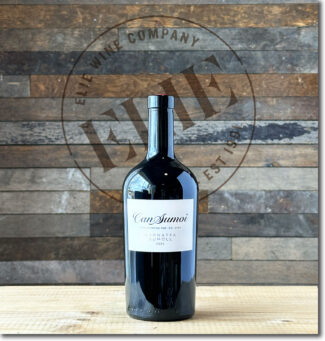 7 Can Sumoi ‘Garnatxa – Sumoll’, 2021 ‘Penedès’ ($28) Red
7 Can Sumoi ‘Garnatxa – Sumoll’, 2021 ‘Penedès’ ($28) Red
Mountain grapes from the highest estate in the Penedès, showing boysenberry, cinnamon and pomegranate while combining rusticity with an essential elegance that is, like salinity, a Can Sumoi trademark.
Priorat
Goliath Into David
In the ever-popular Godzilla trope, the beast periodically rises from slumber and emerges from unforgiving depths to make his presence … well, obvious.
For most of the 20th century, sleepy Priorat remained below the same sort of radar, with vineyards struggling up steep slate hills southwest of Barcelona, content (for the time being) to leave production to cooperatives, who largely made cheap, indifferent wine.
Priorat’s first rage from the obscure into the noteworthy came in the late twentieth century, when young winemakers recognized the potential of the unique Priorat soils—stuff that the Catalans call ‘llicorella’. They found this stony brown slate, occasionally sparkling with quartzite, filled with old-vine Garnatxa and Carinyena that was capable of producing muscular wines of largesse and longevity, and the first wave of truly presentable Priorat wines hit the wine world like a tsunami.
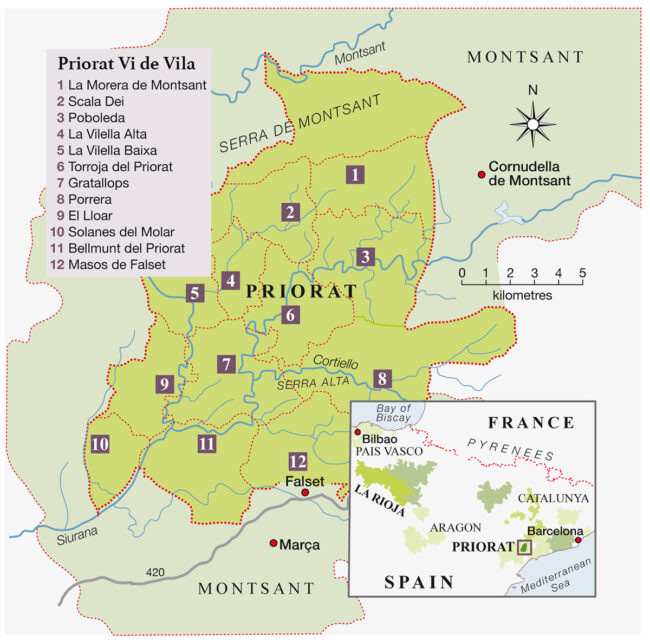
Around 2010, winemakers began to question this style; as tastes changed, such oak-heavy blockbusters lacked the most vital element toward which wine fashion was leaning: Freshness and finesse. In yet another rediscovery of identity and potential, Priorat winemakers began to change their techniques, employing Burgundian methods in part to find floral tones and mineral undercurrents in the classic indigenous grapes, and transforming the gargantuan to the graceful; Goliath, perhaps, into David, or Godzilla into the sleek and streamlined dragons of Greek mythology.
Along with this evolution, the concept of terroir has come to the forefront, with DOQ Priorat exploring a new category, Vi de Vila, in which wine from 12 areas may add the name of the local village to their labels, bringing a sense of identity into an appellation that spent most of its history being somewhat unidentifiable.
Ona
A native Spaniard, born, raised and educated in Barcelona, Núria Garrote i Esteve has dedicated many years to pursuing wine from an elite Franco-Iberian group of trailblazers. Through her partnership with several extraordinarily innovative Catalunyan winemakers, she has assembled a few special collaborative cuvées named after her daughter, Ona. The original labels were written in Ona’s own five-year-old hand, and each wine has a story to tell.
“There are as many points of view articulated through wine and cultivation techniques as there are good wines,” Núria says. “My producers are as different from each other as their farms.”
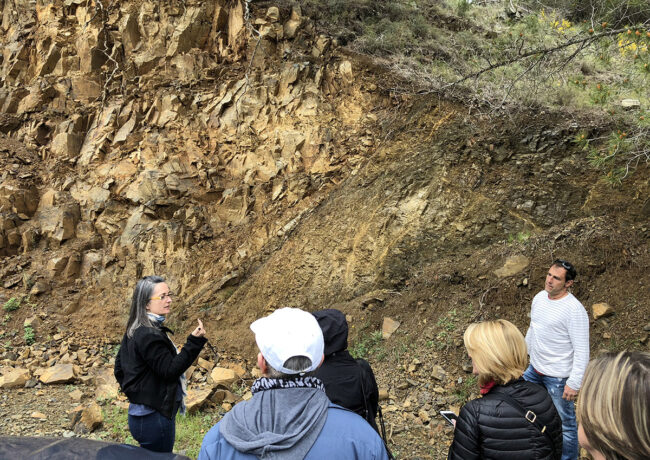
Masos de Falset hillside composed of ‘Llicorella’ consisting of reddish-black slate with small particles of mica quartz, different layers of soil filled in by clayey soil. Clos Petitona winemaker Blai Ferré i Just, right
Among Núria’s Ona-producing partners is Blai Ferré, their first collaboration was in 2013. Blai fell in love with winemaking while a teenager working the fields with one of Priorat’s leading producers, Alvaro Palacios. He then purchased a handful of acres, much of it former vineyard land that had been abandoned, and set to work planting drought-adapted rootstocks and adopting a style of under-extraction to better nurture these wines so that the dazzling minerality of Priorat’s smoky schist can shine through.
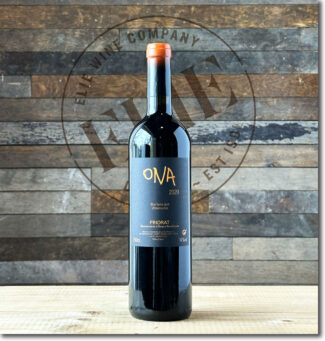 8 Ona, 2020 Priorat ($22) Red
8 Ona, 2020 Priorat ($22) Red
A blend of 40% Garnatxa, 40% Syrah and 20% Carinyena 20% grown on Blai Ferré’s 12 acres; the wine is aged in stainless steel and shows ripe cherry and plum misted in smokiness, spice with wet-stone minerality on the finish. About 5000 bottles produced.
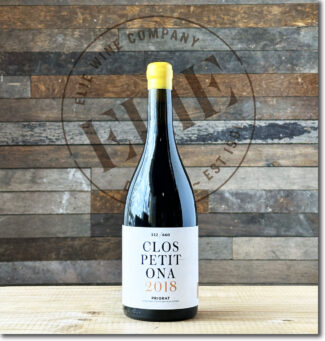 9 Clos Petitona, 2018 Priorat – Masos de Falset ($74) Red
9 Clos Petitona, 2018 Priorat – Masos de Falset ($74) Red
Clos Petitona (Little Ona) is produced from a single plot located in the village of Falset, and is typical of the extreme slopes of the region, terraced against the ravages of time. It was planted in 1949 with equal parts Garnatxa Negra and Garnatxa Peluda vines, with a south-east orientation and a surface area just under four acres. Due to the age of the vines, yields are extremely low, giving the wines superb concentration and structure.
Like the plot itself, Petitona is equal parts traditional Catalan Garnatxa and a variety known as Garnatxa Peluda—‘Hairy’ Garnatxa—because the vine leaves are covered in fine hairs that make it drought resistant. Perfumed rather than floral, the wine shows an earthen nose with baking spice and especially, a touch of licorice-ash, allowing the llicorella soil to live up to its name.
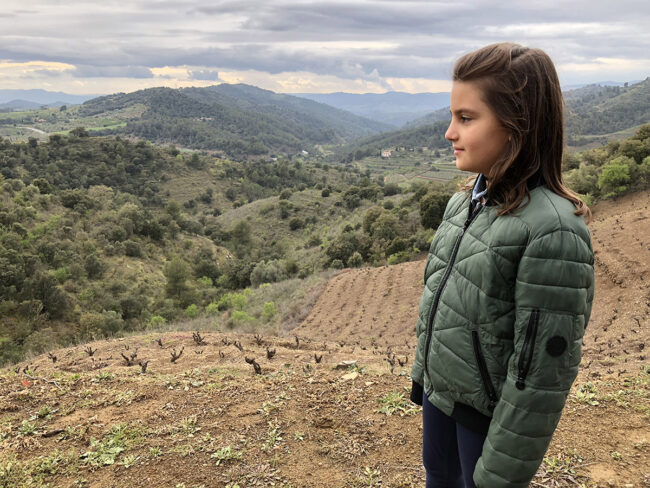
Clos Petitona, Priorat – Vi de Vila ‘Masos de Falset’
Costers-del-Segre
Higher Grounds, Resurrecting Ancient Land
Gradually moving into the modern spotlight, Costers del Segre is a Spanish Denominación de Origen for wines produced in the Catalan province of Lleida. The name is derived from the Segre river which flows from the Pyrenees mountains and reaches the Ebro River south of Lleida. The region grew to prominence as a result of a single estate, Raimat, located near the DO’s westernmost point. Raimat is Spain’s largest privately-owned winery and is considered to be one of its most inventive.
Somewhat unique in the annals of appellations, Costers del Segre was created from four separate sub-zones within a larger region; three further sub-zones were identified in 1998. Altitudes range from 800 feet to 2400 feet, and the influence of the Pyrenees offers a continental climate but the proximity of the Mediterranean reduces the risk of frost when the vines are most vulnerable. The days are warm but the nighttime temperatures are low, ensuring that the grapes retain an excellent spine of acids and structure.
Old vine plots of bush-trained Garnatxa and Macabeu can be found scattered through the region but most of the activity in the last two decades has been new plantings, especially of international varieties in innovative, wire-trained vineyards.
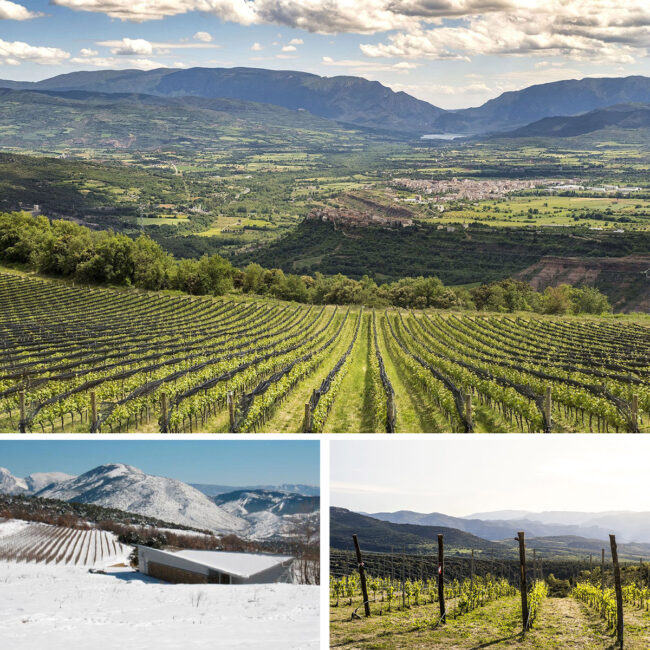
Castell d’Encus, Talarn, Lleida
Castell d’Encus
“Our philosophy is that of an organic vineyard, without herbicides, insecticides or fungicides that are not included in organic practices.” – Raül Bobet
Above all, Castell d’Encus is an experiment, and one that has been approached with all the precision and insight of a research scientist. The goal, from the outset, was to discover the methodology behind reflective, subtle, non-explosive and low-alcohol wines with aging potential at an altitude where even the old-time winemakers claimed that grapes could not thrive.
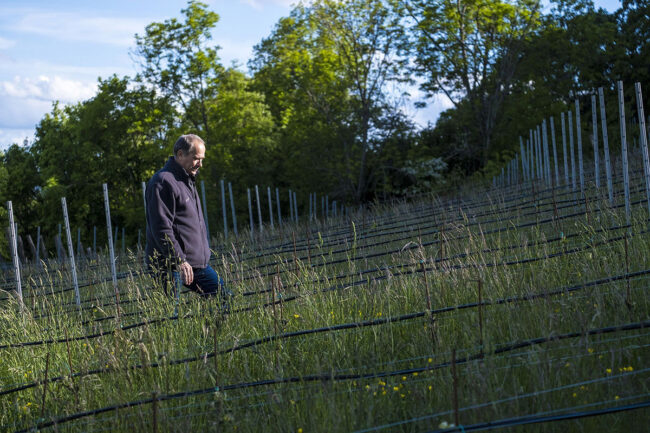
Raül Bobet
But the grand experiment has a more ecological edge, and according to Bobet, “It was vital to us to pair an excellence in mountain winemaking with environmental protection. We want to channel new actions to increase biodiversity and create awareness as an example that everyone can get involved in taking care of the Earth. From our situation, we carry out actions in order to reduce the human impact on the land, the vineyard and the environment, without using herbicides or fungicides. We take advantage of the force of gravity and geothermal energy for certain tasks in the winery.”
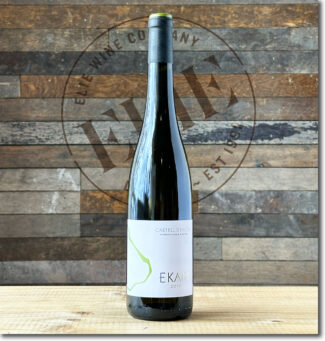 Castell d’Encus ‘Ekam’, 2019 Costers-del-Segre ‘Pallars Jussà’ ($45) White
Castell d’Encus ‘Ekam’, 2019 Costers-del-Segre ‘Pallars Jussà’ ($45) White
85% Riesling and 15% Albariño sourced from a cool, southwest-facing plot in the Pallars Jussà comarca, located between the Lleida Plain and the Pyrenees. Ekam means ‘divine unity’ in Sanskrit and offers an intense bouquet of kiwi, grapefruit, peach and ripe green apple and light kerosene notes which will develop and mature with age. Fermented in 2500 and 5000-liter tanks at low temperature, it is ‘trocken’, or dry. 2500 cases made.
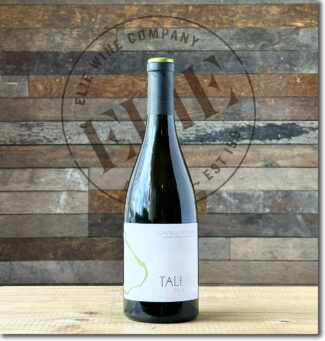 Castell d’Encus, 2018 ‘Taleia’ Costers-del-Segre ‘Pallars Jussà’ ($48) White
Castell d’Encus, 2018 ‘Taleia’ Costers-del-Segre ‘Pallars Jussà’ ($48) White
95% Sauvignon Blanc, 5% Semillon; this classic Bordeaux lowland blend as interpreted by Raül Bobet’s mountain sensibilities: Fermented on native yeast in a combination of medieval stone vats, French oak and stainless steel, a time on the lees adds richness and complexity. The wine presents notes of vanilla from the barrel-time, which melds wonderfully with the fruit’s essential quince, apricot, lime and straw flavors. 1700 cases made.
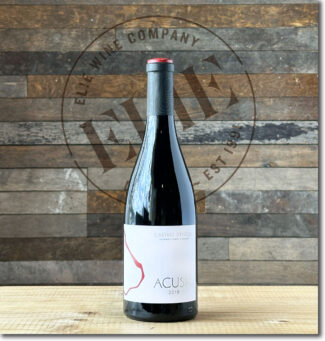 Castell d’Encus ‘Acusp’, 2018 Costers-del-Segre ‘Pallars Jussà’ ($66) Red
Castell d’Encus ‘Acusp’, 2018 Costers-del-Segre ‘Pallars Jussà’ ($66) Red
Hand-harvested using small, 10 kg crates, this 100% Pinot Noir wine, drawn from high-density vines, was fermented in a combination of stainless-steel tanks and in the open-air stone vats. It underwent secondary, malolactic fermentation in French oak barrels and has a light, silky mouthfeel with modest tannins and acidity behind savory, earthy aromatics accented by scents of white peaches, lilac and bright citrus, raspberry and chalk. 1500 cases made.
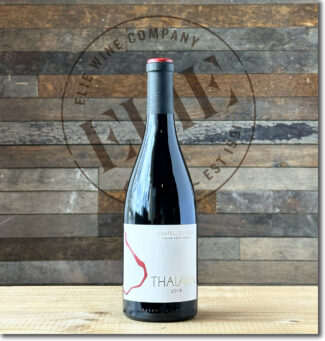 Castell d’Encus ‘Thalarn’, 2018 Costers del Segre ‘Pallars Jussà’ ($63) Red
Castell d’Encus ‘Thalarn’, 2018 Costers del Segre ‘Pallars Jussà’ ($63) Red
100% hand-harvested Syrah fermented in the 12th century carved stone vats on the property, the remainder in new French wood and stainless-steel vats. 100% of the wine underwent malolactic fermentation in French oak barrels, where it then aged for 12 months. The wine shows notes of chocolate and plum with a lighter hints of tobacco, blackberry jam and a dusting of cinnamon, with licorice on the finish.
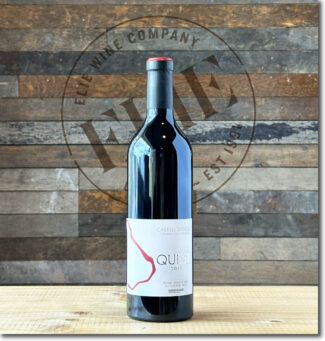 Castell d’Encus ‘Quest’, 2017 Costers-del-Segre ‘Pallars Jussà’ ($66) Red
Castell d’Encus ‘Quest’, 2017 Costers-del-Segre ‘Pallars Jussà’ ($66) Red
‘Quest’ is the heart of the matter—the question itself: Can Bordeaux varieties produce at such elevations? The answer is yes, as this elegant blend of 55% Cabernet Sauvignon, 20% Merlot, 15% Cabernet Franc and 10% Petit Verdot demonstrates. 100% fermented in the estate’s famous stone vats, Quest displays a nicely concentrated profile with bright summer fruit and the hint of green pepper that is often a hallmark of cool climate reds. The tannins are finely-grained and linger with the acidity, showing great potential for cellaring. 360 cases made.
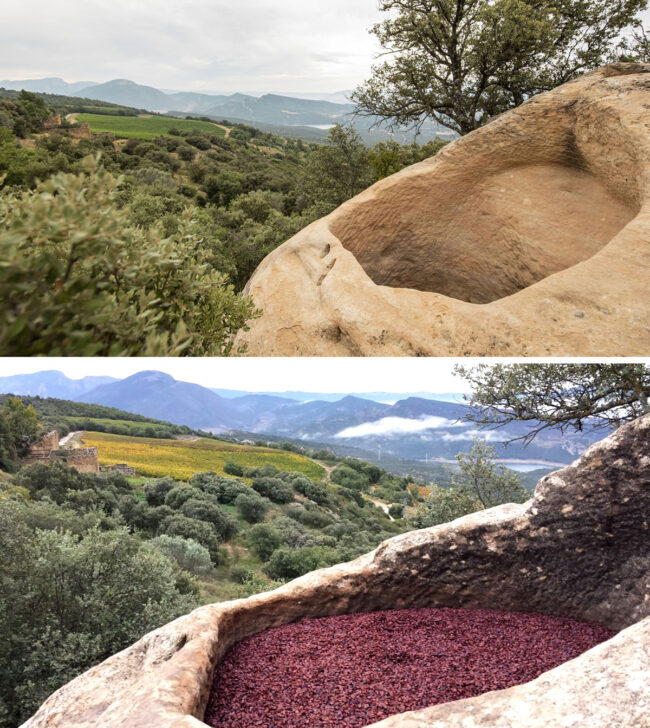
12th Century Stone Vats (Fermenters)
- - -
Posted on 2024.04.23 in France, Saturday Sips Wines, Penedes, Priorat DOQ, Wine-Aid Packages, Catalunya, Costers del Segre
Featured Wines
- Notebook: A’Boudt Town
- Saturday Sips Wines
- Saturday Sips Review Club
- The Champagne Society
- Wine-Aid Packages
Wine Regions
Grape Varieties
Albarino, Albarín Blanco, Albarín Tinto, Albillo, Aleatico, Aligote, Arbanne, Aubun, Barbarossa, barbera, Biancu Gentile, bourboulenc, Cabernet Franc, Caino, Caladoc, Calvi, Carcajolu-Neru, Carignan, Chablis, Chardonnay, Chasselas, Cinsault, Clairette, Corvina, Counoise, Dolcetto, Erbamat, Ferrol, Frappato, Friulano, Fromenteau, Gamay, Garnacha, Garnacha Tintorera, Gewurztraminer, Graciano, Grenache, Grenache Blanc, Groppello, Juan Garcia, Lambrusco, Loureira, Macabeo, Macabou, Malbec, Malvasia, Malvasia Nera, Marcelan, Marsanne, Marselan, Marzemino, Mondeuse, Montanaccia, Montònega, Morescola, Morescono, Moscatell, Muscat, Natural, Niellucciu, Parellada, Patrimonio, Pedro Ximénez, Petit Meslier, Petit Verdot, Pineau d'Aunis, Pinot Blanc, Pinot Gris, Pinot Meunier, Pinot Noir, Pouilly Fuisse, Pouilly Loche, Poulsard, Prieto Picudo, Riesling, Rondinella, Rose, Rousanne, Roussanne, Sagrantino, Sauvignon Blanc, Savignin, Sciacarellu, Semillon, Souson, Sparkling, Sumoll, Sylvaner, Syrah, Tannat, Tempranillo, Trebbiano, Trebbiano Valtenesi, Treixadura, Trousseau, Ugni Blanc, vaccarèse, Verdicchio, Vermentino, Xarel-loWines & Events by Date
- July 2024
- June 2024
- May 2024
- April 2024
- March 2024
- February 2024
- January 2024
- December 2023
- November 2023
- October 2023
- September 2023
- August 2023
- July 2023
- June 2023
- May 2023
- April 2023
- March 2023
- February 2023
- January 2023
- December 2022
- November 2022
- October 2022
- September 2022
- August 2022
- July 2022
- June 2022
- May 2022
- April 2022
- March 2022
- February 2022
- January 2022
- December 2021
- November 2021
- October 2021
- September 2021
- August 2021
- July 2021
- June 2021
- May 2021
- April 2021
- March 2021
- February 2021
- January 2021
- December 2020
- November 2020
- October 2020
- September 2020
- August 2020
- July 2020
- June 2020
- May 2020
- April 2020
- March 2020
- February 2020
- January 2020
- December 2019
- November 2019
- October 2019
- September 2019
- August 2019
- July 2019
- June 2019
- May 2019
- April 2019
- March 2019
- February 2019
- January 2019
- December 2018
- November 2018
- October 2018
- September 2018
- August 2018
- July 2018
- June 2018
- May 2018
- April 2018
- March 2018
- February 2018
- January 2018
- December 2017
- November 2017
- October 2017
- September 2017
- August 2017
- July 2017
- June 2017
- May 2017
- April 2017
- March 2017
- February 2017
- January 2017
- December 2016
- November 2016
- October 2016
- September 2016
- August 2016
- July 2016
- June 2016
- May 2016
- April 2016
- March 2016
- February 2016
- January 2016
- December 2015
- November 2015
- October 2015
- September 2015
- August 2015
- July 2015
- June 2015
- May 2015
- April 2015
- March 2015
- February 2015
- January 2015
- December 2014
- November 2014
- October 2014
- September 2014
- August 2014
- July 2014
- June 2014
- April 2014
- March 2014
- February 2014
- January 2014
- December 2013
- November 2013
- October 2013
- September 2013
- August 2013
- July 2013
- June 2013
- May 2013
- April 2013
- March 2013
- February 2013
- January 2013
- December 2012
- November 2012
- October 2012
Search



